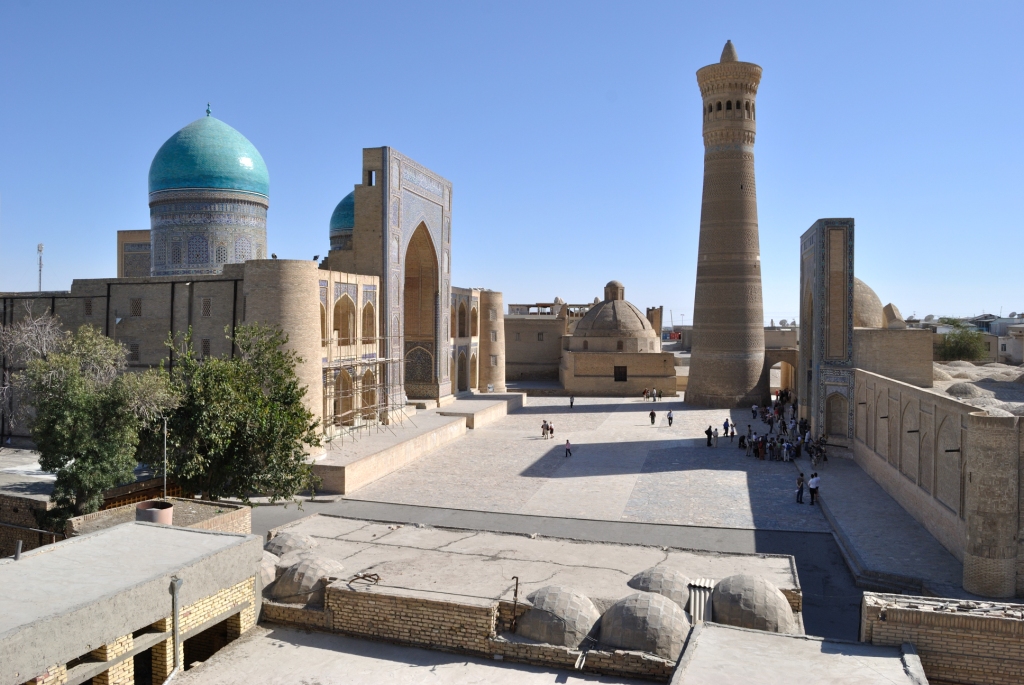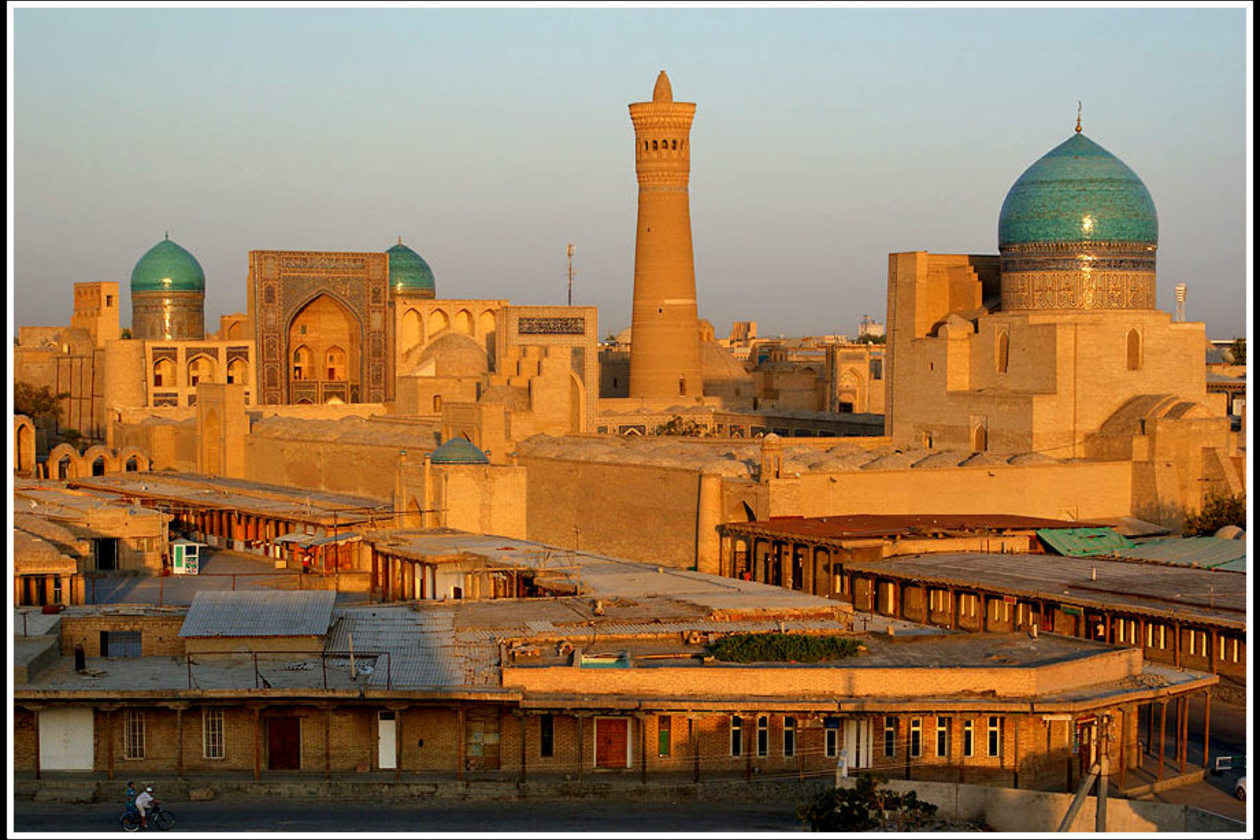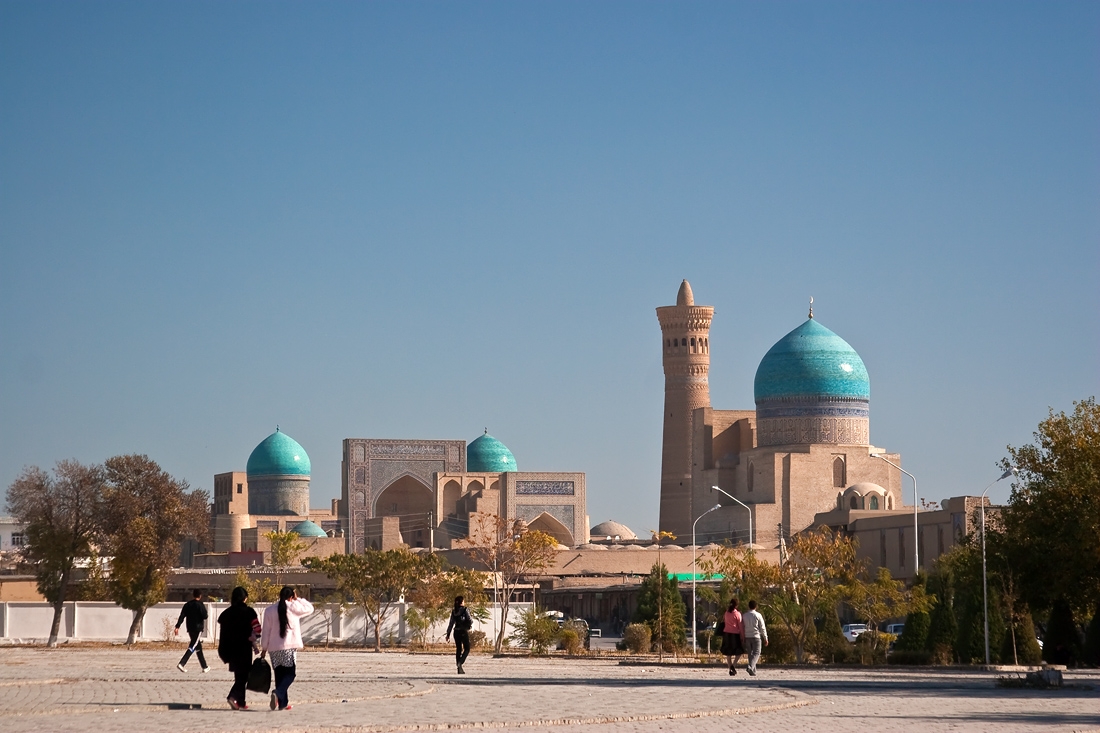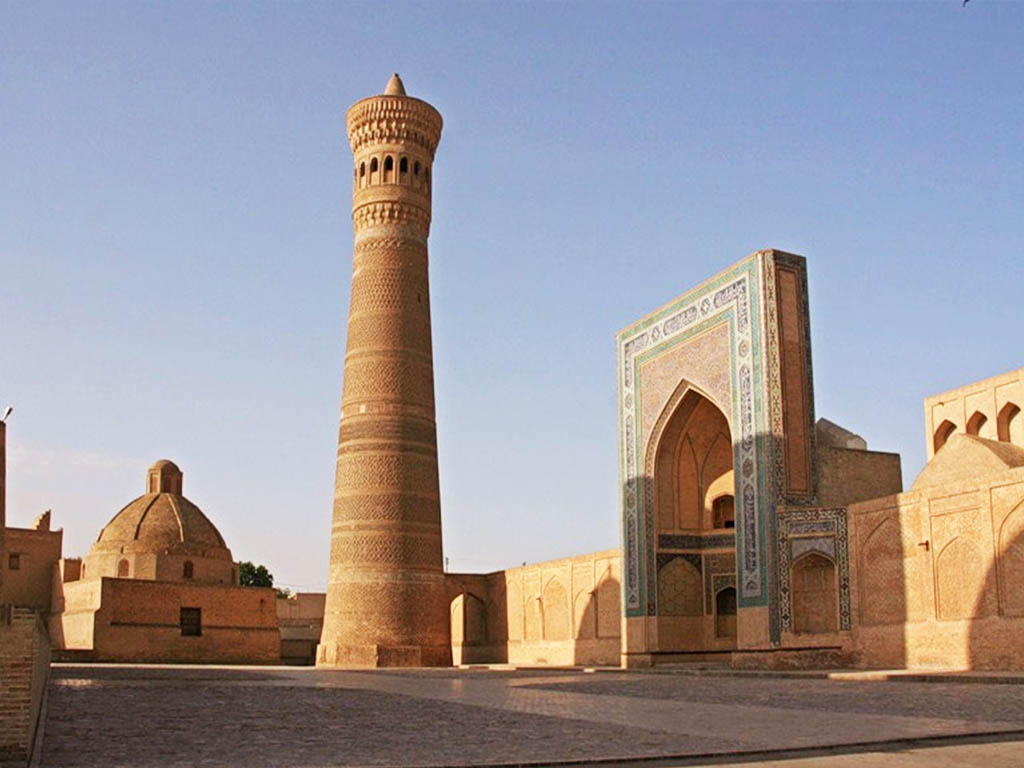Po-i-Kalyan or Poi Kalyan, is an Islamic religious complex located around the Kalyan minaret in Bukhara, Uzbekistan.
The complex is located in the historic part of the city. Since 713, several ensembles of main mosques were built in this area, to the south of the Ark citadel. One of these complexes, burned down by Genghis Khan during the siege of Bukhara, was built in 1121 by the Karakhanid ruler Arslan-khan. The Kalyan minaret is the only one of the structures of Arslan-han complex that was kept safe during that siege.
The Kalyan minaret is known more properly as Minâra-i Kalân (Pesian/Tajik for the "Grand Minaret"). It is also known as the Tower of Death because for centuries criminals were executed by being thrown from the top.
The minaret is the most famed part of the complex, which dominates the historical center of the city in the form of a huge vertical pillar. The role of the minaret is largely for traditional and decorative purposes - its dimension exceeds the bounds of the main function of the minaret, which is to provide a vantage point from which the muezzin can call people to prayer. For this purpose it was enough to ascend to a roof of the mosque. This practice was common in initial years of Islam. The word "minaret" is derived from the Arabic word "manara" ("lighthouse", or more literally "a place where something burn"). Probably the idea for the minarets of Islam was adopted from "fire-towers" or lighthouses of previous epochs.
The architect, whose name was simply Bako, made a minaret in the form of a circular-pillar brick tower, narrowing upwards, of 9 meters (29.53 feet) diameter at the bottom, 6 meters (19.69 feet) overhead and 45.6 meters (149.61 feet) high. There is a brick spiral staircase that twists up inside around the pillar, leading to the landing in sixteen-arched rotunda - skylight, which based on a magnificent stalactite cornice (sharafa).
Kalyan Mosque (Maedjid-i kalyan) was completed circa 1514, in the Khanate of Bukhara. It is equal in size to the Bibi-Khanym Mosque in Samarkand. Although they are both mosques, they are very different in architectural styles. The roof of the galleries encircling the mosque's inner courtyard has 288 domes resting on 208 pillars. Facing the courtyard is a tall tiled Iwan portal, for entry to the main prayer hall. The mosque is surmounted by a large blue tiled dome.
The place where the complex Po-i-Kalyan is located is the site of a few completely ruined buildings from the past. In pre-Islamic era there was a central cathedral for fire-worshippers. Since 713 here, at the site south of the Ark, several edifices of main cathedral mosque were built then razed, restored after fires and wars, and moved from place to place. In 1127, the Karakhanid ruler Arslan-khan completed construction on the cathedral mosque with the minaret. The greatness of the structures so amazedGenghis Khan, he mistakenly believed the mosque to be a khans' palace. Nevertheless, the building of the mosque was not spared by the fire, and for many years after the conflagration it lay in ruins. All that remained intact of the original building was the minaret Kalyan (Minara-yi-Kalyan).
After the death of Shaibani-khan in 1510, most local rulers (emirs and sultans) only partially recognized the central government. The capital of the Shaibanid state was in Samarkand. In 1512 the nephew of Shaibani-khan, the young prince Muizz ad-Din Abu-l Gazi Ubaidullah, became sultan of Bukhara. He inherited the power from his father Mahmud-sultan, who was the cadet brother of Shaibani-khan and his faithful companion-in-arms. Until 1533, Ubaidullah-sultan was a successful governor of Bukhara, when he was enthroned as a khan of whole Shaibanid state - khan of Maverannahr (Ma wara'u'n-nahr). In spite of this he refused to move his residence to Samarkand - the state capitol. Moreover, he later made Bukhare the capital of the Shaibanid state. Afterwards, the state governed by Ubaidullah (Ubaidulla) received a new name - Bukhara khanate. Thus Ubaidullah-khan (gov. 1533-1539) became the first khan of Bukhara khanate. While Ubaidullah-khan was the khan of Maverannahr, his son Abdul-Aziz-khan was the khan of Bukhara. They considered Bukhara to be their family lot. They were patriots of Bukhara and cared for success of the city.
The fact that the governor of Bukhara in 1514 built such grand mosque, which could rival with the symbol of royal Samakand - the Bibi-Khanym Mosque, shows a tendency to eventually make Bukhara the capital of the Shaibanid state. By the construction of Kalyan Mosque, Ubaidullah-sultan started the formation of a new capital, rather than fighting for domination over Samarkand, which was always hostile to Shaibanids.
The construction of Mir-i-Arab Madrasah (Miri Arab Madrasah) is credited to Sheikh Abdullah Yamani of Yemen. Also called Mir-i-Arab, he was considered the spiritual mentor of Ubaidullah-khan and his son Abdul-Aziz-khan. Ubaidullah-khan waged a successful war against Iran. At least three times his troops seized Herat. Each plundering raid on Iran resulted in the capture of a great many captives. The money Ubaidullah-khan earned from selling three thousand Persian captives funded the construction of Mir-i-Arab Madrasah. Ubaidullah-khan was very religious. He had been nurtured in high respect for Islam in the spirit of Sifism. His father named him in honor of prominent sheikh of the 15-th century Ubaidullah al-Ahrar (1404-1490), by origin from Tashkent province.
By the 1630s, sovereigns no longer erected splendid mausoleums for themselves and for their relatives. Khans of Shaibanid dynasty were standard-bearers of Koran traditions. The significance of religion was so great that even such a famed khan as Ubaidullah was buried next to his mentor in his madrasah. In the middle of the vault (gurhana) in Mir-i-Arab, Madrasah is situated in the wooden tomb of Ubaidullah-khan. At his head is wrapped in the moulds his mentor - Mir-i-Arab. Muhammad Kasim, mudarris (a senior teacher) of the madrasah (died in 1047 hijra) is also interred nearby.
The portal of Miri Arab Madrasah is situated on one axis with the portal of the Kalyan Mosque. However, because of some lowering of the square to the east, it was necessary to raise the edifice of the madrasah on a platform.













